A Classic Reborn: a Review of BLACK ODYSSEY at CalShakes
August 14, 2017 § Leave a Comment
At the center of poet/playwright Marcus Gardley’s black odyssey (now playing at the California Shakespeare Theater) is the eternal impulse to retell a classic tale in order to claim it as one’s own. For those of us who regularly teach the classics, this is the lesson we seek to foster: the purpose of retelling these stories is not to perpetuate the past, but to connect to it. It is impossible to leave Eric Ting’s masterful production without feeling a part of something bigger than one’s own limited space and time.
A Paradox
Gardley’s reworking of the Homeric epic gains its force from the paradoxical rule that universality is achieved not by vacuous generality, but in precise specificity. On its surface, his play is about an African-American veteran of the contemporary (and ongoing) war in Afghanistan, named Ulysses Lincoln, who cannot find his way home. Over the course of the evening it becomes clear, however, that he is not so much geographically lost as spiritually at sea. His journey is not just finding his home, but finding himself.
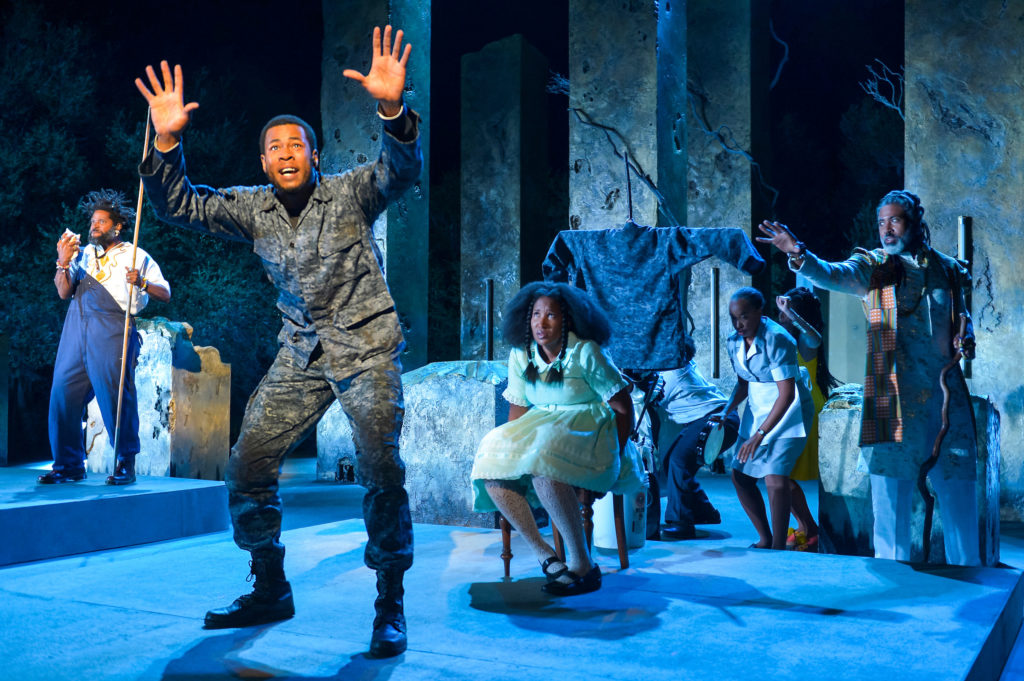
(l to r) Aldo Billingslea (Great Grand Paw Sidin), J. Alphonse Nicholson (Ulysses Lincoln), Safiya Fredericks (Benevolence Nausicca Sabine), Dawn S. Troupe (Alsendra Sabine) and Lamont Thompson (Great Grand Daddy Deus); photo by Kevin Berne
After being swept overboard of the ship carrying him home by a wave caused by the vengeful sea god, he washes up on a shore that – we slowly realize – is located both far from his intended destination and decades before he was born. The path to self-knowledge runs through the discovery of a history that was in some ways actively withheld from him through erasure and distortion, and in other ways that he actively fled when he joined the army to get himself out of Oakland. Although this is one man’s specific story, Gardley guides us to seeing beyond the surface, making it also a story about all of us.
Epic
Like any true epic, the plot is anything but linear. It is dotted with witty reïmaginings of the arbitrary and capricious Greek gods Paw Sidin (Poseidon), Aunt Tina (Athena) and Great Grand Daddy Deus (whose name is pointedly changed from Zeus to the Latin generic term for “god,” presumably because it also applies to the god of Christian tradition) who toy with human fate for reasons of their own. It retains the secondary story of the struggles of his wife, Penelope (here called Nella P.), and son, Telemachus (Malachai in Gardley’s version), to survive and retain hope, while placing them in a very recognizable 21st century Oakland. Often it focuses on the surreal experiences of the wandering Ulysses.
Along the way Gardley invokes Hurricane Katrina, the string of assassinations of civil rights leaders, Abraham Lincoln, JFK, Treyvon Martin, the death of Oscar Grant in the Fruitvale BART Station, reconstruction, and a host of other historical and local references that stir times and places together poetically. Painfully, I saw the opening night performance just hours after a white supremacist march in Charlottesville, Virginia, erupted in fatal violence against counter-protesters, which did not need to be directly referenced in order to be part of the mix.
A Great Feast of Language
Gardley is as much poet as playwright. His rhythms, rhymes and wordplay are both stunningly current and historically apt. For anyone who loves language black odyssey is a feast. CalShakes consistently demonstrates careful attention, not only to what is said, but how it is said. Gardley is at his most Homeric in his extravagant use of poetic artifice, and the producing company serves his inventive wit well.
The production heavily features music, especially arrangements of traditional spirituals. Vocal composers Linda Tillery and Molly Holm produced the strongest musical ensemble I have seen at CalShakes. (Tillery is also the credited Music Director, while Holm is also listed as Vocal Ensemble Director.) While I was less impressed with the brief forays into pop music in the second act, it is hard to underestimate how much of the overall impact of the production is built on the musical components. When the full cast is united in a choral moment, which happens rather often, the wall of sound they create is viscerally moving.
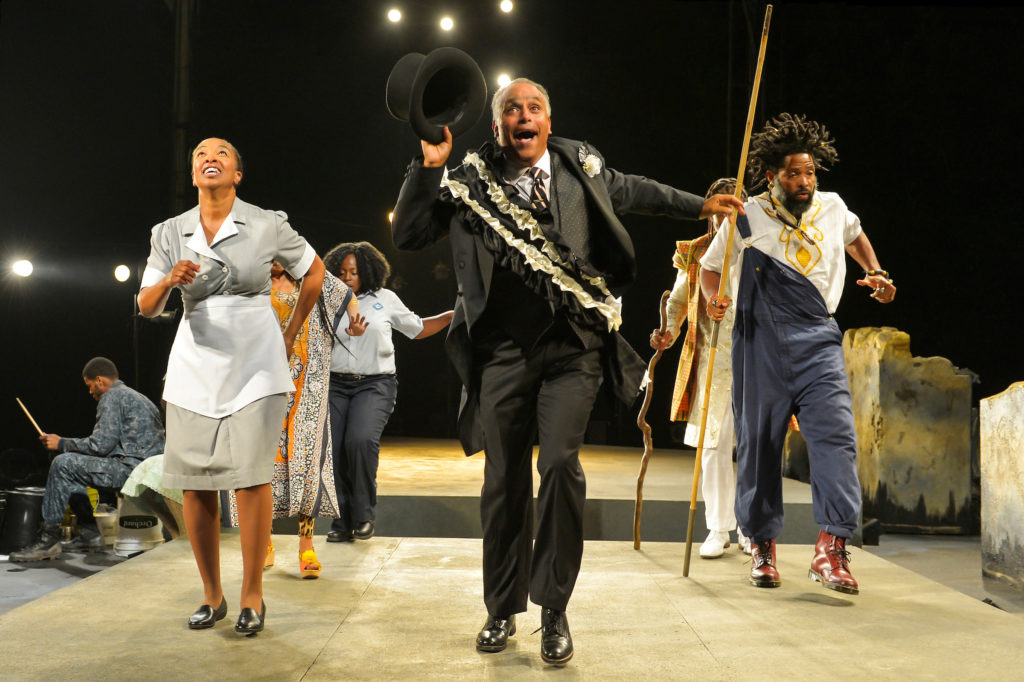
The cast of Marcus Gardley’s black odyssey directed by Eric Ting at California Shakespeare Theater; photo by Kevin Berne
Nine Stars
However much all of that matters, the evening is also about basking in the masterful performances of an exceptional cast. As Ulysses, actor/percussionist J. Alphonse Nicholson accomplishes the enormously challenging task of portraying a lost soul without fading from focus or losing his energy. His humanity and generosity as a performer letting us glimpse his innermost self allows us to identify with him intensely. Omozé Idehenre proves an emotional anchor for the entire evening as his long-suffering wife. Newcomer Michael Curry completes the family trinity as his son, Malachai, movingly and believably, even when the role shines an unsympathetic light on his character. In a conventional drama, this family grouping would be our entire focus and we would be content with such central performances.
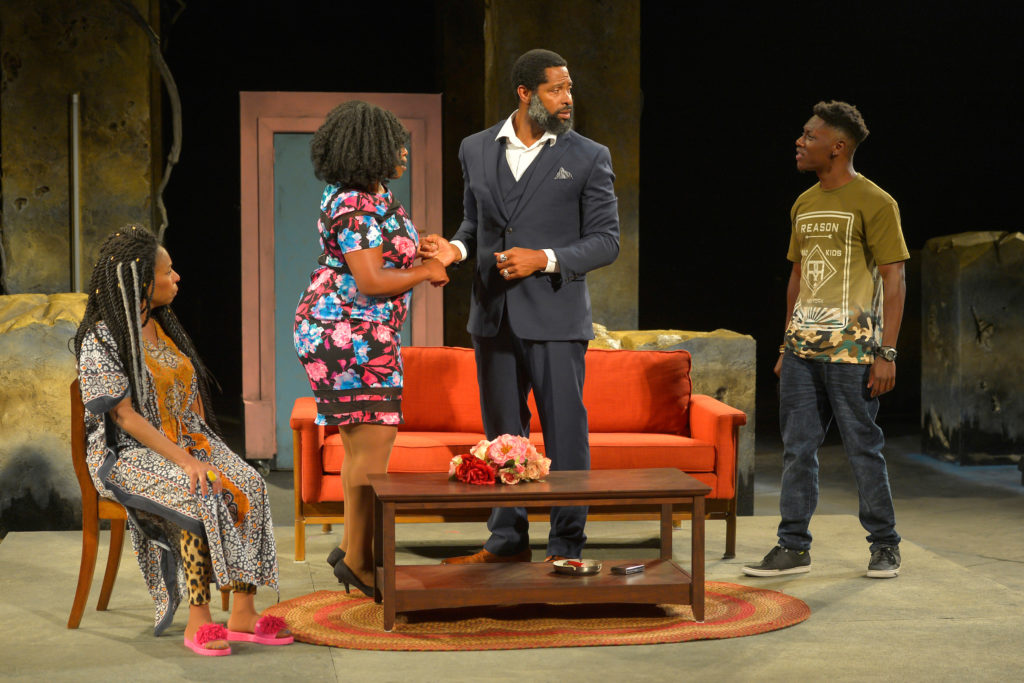
(l to r) Margo Hall (Great Aunt Tina), Omozé Idehenre (Nella Pell), Aldo Billingslea (Suitor), and Michael Curry (Malachai); photo by Kevin Berne
In this cast, however, the peripheral players are every bit as compelling. CalShakes regulars Aldo Billingslea and Margo Hall are powerhouses as the squabbling gods whose conflict lies behind Ulysses’ trials. Both also demonstrate astonishing versatility as they transform into their respective gods’ alter-egos. Billingslea invokes Paw Sidin as a coverall-clad levee fisherman but when he incarnates as a smooth-talking suit salesman wooing Nella P., a crisp military officer offering the wrong kind of solace when he brings news that Ulysses is lost and presumed dead, and a terrifying policeman, he appears completely different in each case. When Hall’s Athena sloughs off her immortality to become Aunt Tina, an aging and ill human, we see her change right before our eyes. And her invocation of Tina Turner (as one of the Sirens) is, well, let’s just say worth the price of admission all by itself.
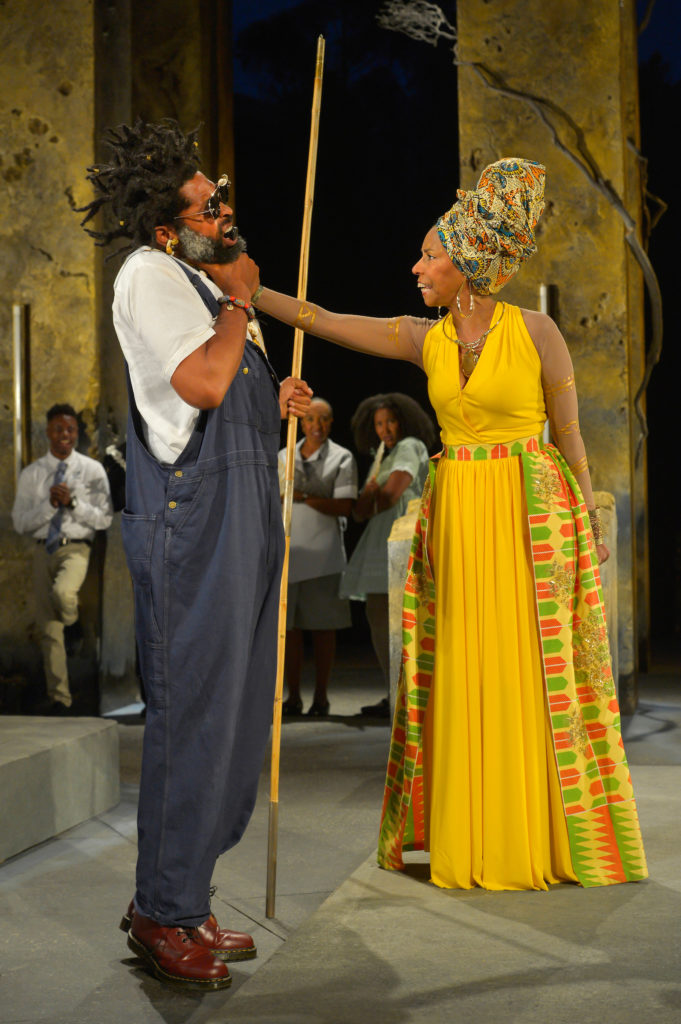
Foreground: Aldo Billingslea (Great Grand Paw Sidin), Margo Hall (Great Aunt Tina); rear: Michael Curry, Dawn L. Troupe, and Safiya Fredericks. Photo by Kevin Berne
Are these five great performers the magic number? Hardly. They are actually just the start of a cast of astonishing depth. Lamont Thompson as Daddy Deus is majestic, and in various minor roles he ranges from mysterious to hilarious. Bay Area playwright/performer Michael Gene Sullivan (best known for his work with the San Francisco Mime Troupe) appears – and sometimes disappears into – so many guises it’s hard to stay clear that it is the work of just one man and not a cast of dozens filling in. Dawn L. Troupe is Sullivan’s female equivalent in the cast playing a range of roles, sometimes prominent and sometimes almost invisible, providing enormous texture and depth to the play.

Dawn L. Troupe as Circe and J. Alphonse Nicholson as Ulysses Lincoln in Marcus Gardley’s black odyssey directed by Eric Ting at California Shakespeare Theater; photo by Kevin Berne
The nine-person cast is rounded out by Safiya Fredericks, whose light and amusing performance of Ulysses’ childish traveling companion conceals an artfulness and control that is only revealed when the entire play has unfolded. It is unfair that her masterful work cannot be discussed in detail without spoiling the play, but it can be said without harm that her genius lies in knowing when and how to unleash her talent, and it is worth the wait.
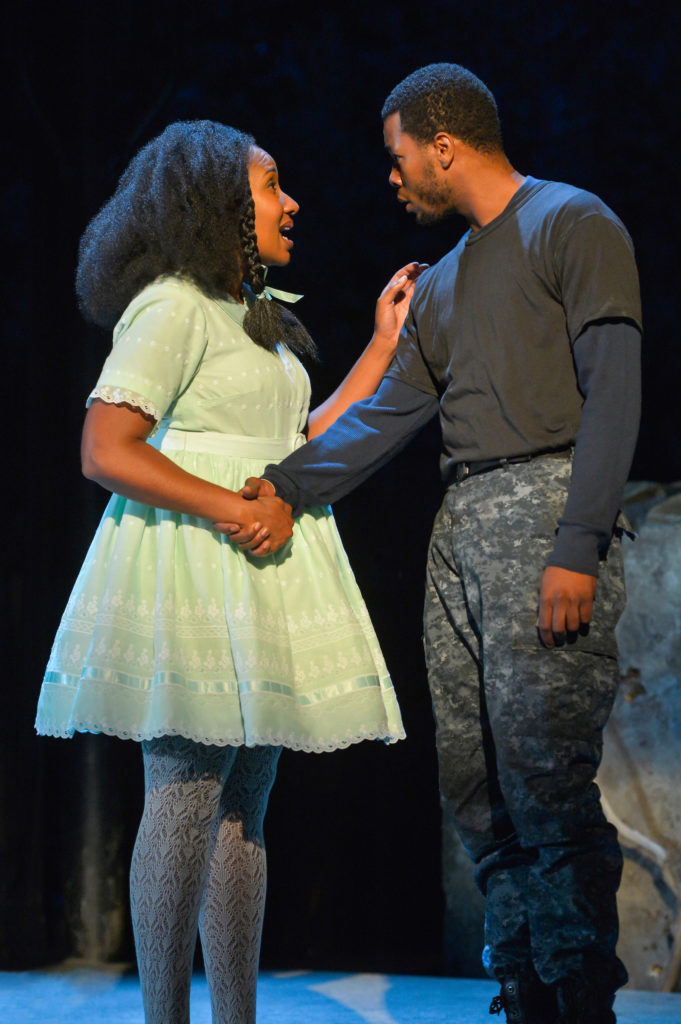
Safiya Fredericks (Benevolence Nausicca Sabine) and J. Alphonse Nicholson (Ulysses Lincoln); photo by Kevin Berne
One Small Man in a Huge World
The action of the play happens almost exclusively on an empty platform in front of Michael Locher’s monumental set, but the dynamic visual impression created by the towering (and crumbling) pillars sets the right tone throughout the night. Locher is especially successful at tying the stage space to CalShakes’ astounding natural setting in the Berkeley hills. That gorgeous view is always one of the pleasures of attending a CalShakes production. In a piece this grounded locally, it was especially admirable that the surrounding environment was featured. Abetted by the outstanding work of Lighting Designer Xavier Pierce, both the onstage action and the larger surroundings remain in balance. Thematically evocative, the image of one small man making his way in the huge world could not have been more beautifully rendered. Costumes by Dede M. Ayite successfully mix the mundane (for scenes of domestic depression) and the fantastic (in the otherworldly visions of Ulysses), which is not an easy trick to pull off.
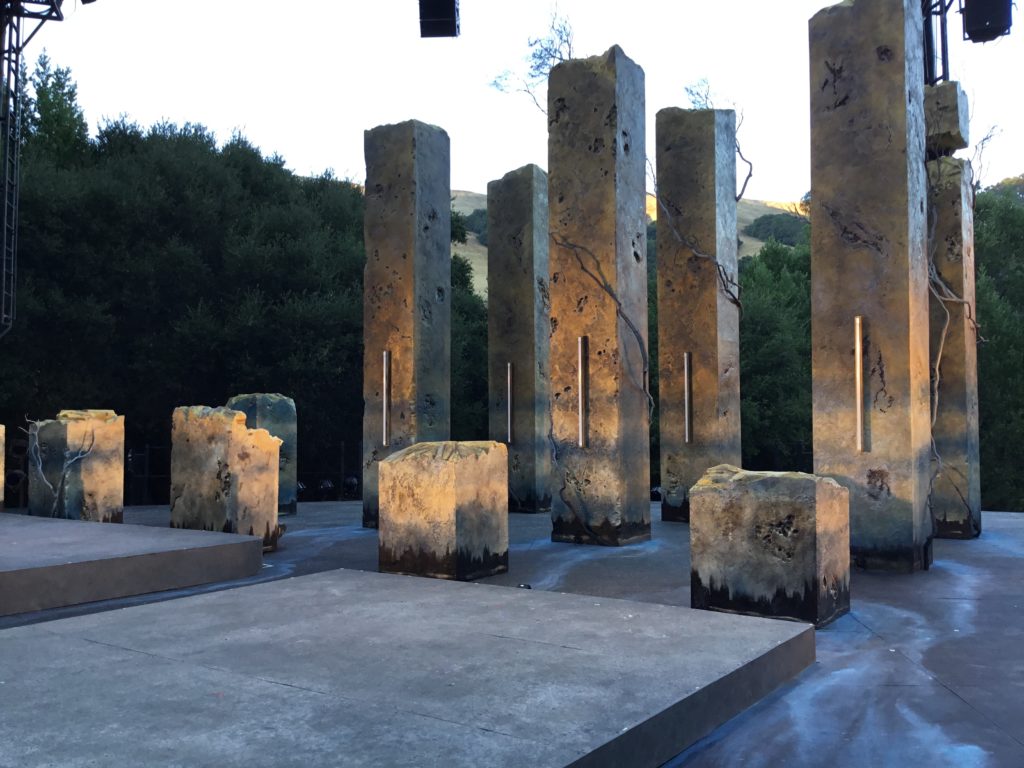
Michael Locher’s set lit by the pre-show sunset. Photo by the author.
Empathy
Ting’s directing is an astonishing act of empathy by a man who is, after all, of Asian-American decent, who is empowering an African-American cast to claim and interpret a story whose specifics are outside his direct experience. In his company debut as a director a year ago his Brechtian production of Othello proved controversial in part because (as is the way with such productions) we were not so much asked to empathize with Shakespeare’s hero, but told to do so. I am among those who actually like a stern lecture now and then and I liked Ting’s production, but I concede it was more Brecht than Shakespeare.
In this case, Ting seems an absolute servant to Gardley’s vision. It is hard for me to imagine that even those who found his Othello difficult will not find this an inviting experience. It is a sensitive and insightful rendition of a beautiful play, allowing a local playwright and cast to stake a claim on a work considered foundational to the Western tradition in a truly universal way. By making Homer their own they remind us that no one owns or directly inherits the past. We all have to find our humanity.
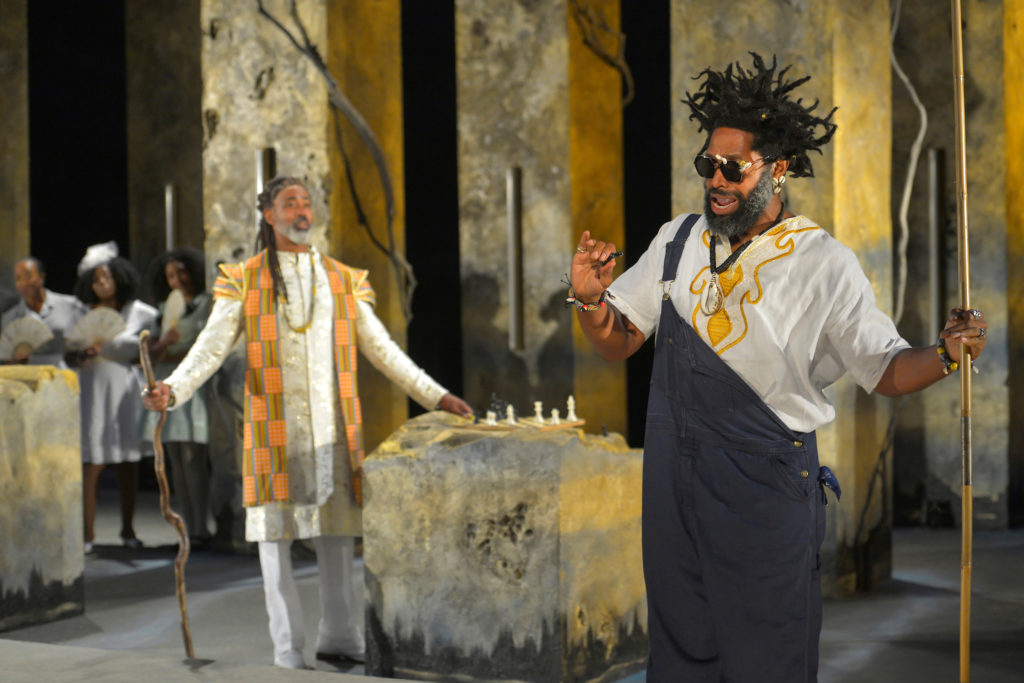
(l to r) Lamont Thompson as Great Grand Daddey Deus plays chess with Aldo Billingslea as Great Grand Paw Sidin, while Dawn L. Troupe, Omozé Idehenre, and Safiya Fredericks look on in Marcus Gardley’s black odyssey directed by Eric Ting at California Shakespeare Theater; photo by Kevin Berne
Production seen on August 12 2017
WHEN: through September 3, 2017
Tuesdays through Thursdays at 7:30pm, Fridays and Saturdays at 8pm, Sunday Matinees at 4pm
WHERE: Bruns Amphitheater, 100 California Shakespeare Theater Way, Orinda, CA 94563
INFO: www.calshakes.org
AS YOU LIKE IT, but like you’ve never seen it… at CalShakes
May 31, 2017 § Leave a Comment
Desdemona Chiang’s smart, contemporary production of As You Like It for CalShakes turns the play inside out, resulting in an extraordinarily moving and revelatory performance.
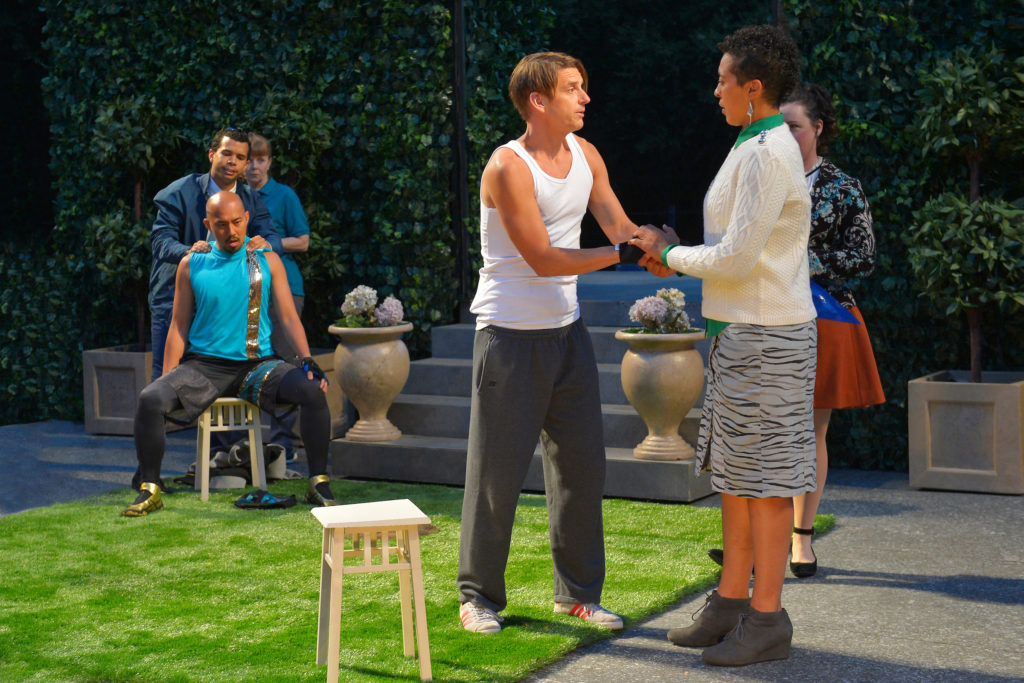
(L to R, front) Jomar Tagatac (seated) as Charles the Wrestler, Patrick Russell as Orlando and Jessika D. Williams as Rosalind photo by Kevin Berne.
Chiang takes everything we have come to expect from this pleasant (if usually light-weight) comedy and stands it on its head. From arrival in the auditorium until the curtain call, she finds unexpected depth and intensity by reimagining the setting, the period and the context of the show.
From Green World to Cityscape
The first glimpse of Nina Ball’s evocative set (waiting on the open stage of CalShakes’ beautiful outdoor location in the foothills just beyond Berkeley) is of a gorgeously manicured ivy-covered wall and topiary garden. Reversing the usual trope, this particular “green world” proves to be the unhappy home of the heroine, rather than the expected idyllic wood to which she will later be forced to flee.

Nina Ball’s beautiful “green wall” in the pre-show sunset.
When that heroine, Rosalind, is spitefully banished by her malicious uncle, she adopts male disguise and decides to seek her exiled father in the Forest of Arden. Ball’s set revolves and suddenly… we are in a dark, industrial back-alley, where the homeless and dispossessed occupy deserted loading docks stacked high with abandoned shipping containers. It is an apt contemporary analog for the dangerous backwoods of Shakespeare’s era, but unlike any design choice I have previously seen.
On the surface level, this resetting is not an easy fit. The rustics in the “woods” retain their pastoral concerns from deer hunting to sheep herding, while Rosalind (along with the cousin and court jester that agreed to accompany her) speak admiringly of the beauty of the place. The urban jungle we see and the idyllic pastoral vista we hear described are jarringly at odds.
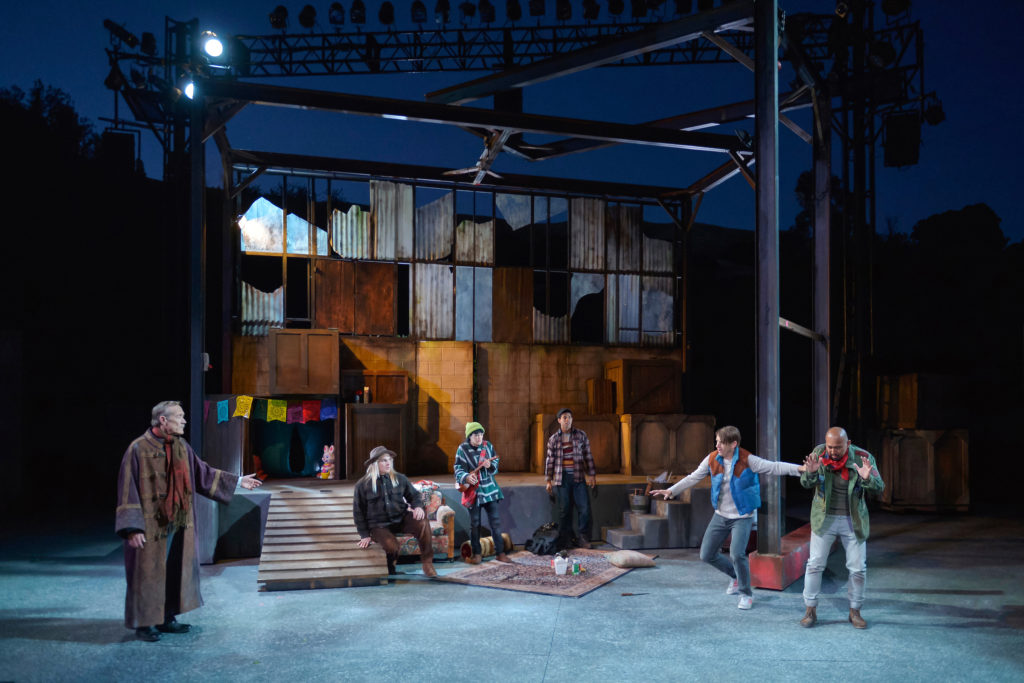
(L to R) James Carpenter (Duke Senior), Craig Marker (Amiens), Lisa Hori-Garcia (Second Lord), William Thomas Hodgson (First Lord), Patrick Russell (Orlando) and Jomar Tagatac (Jaques) on Nina Ball’s urban jungle set.
Chiang’s genius lies in slowly seducing us into an even-greater-than-usual suspension of disbelief so that we might look past these surface discordances and discover the play’s deepest core. Her allies in this are her exceptional design team, which in addition to Ball includes costume designer Melissa Torchia, lighting designer Masha Tsimring and sound designer Sharath Patel. They build a world that looks nothing like what is said to be their location, but feels exactly right for a place that is “uncivilized,” and therefore at once dangerous yet freeing.
Finding Ganymede
It is the performance of Jessika D. Williams as Rosalind that pushes the production to truly remarkable heights. In this dangerous new environment, her version of the protagonist has good reason to disguise herself as the male Ganymede, but in Williams’ interpretation what begins as a disguise becomes a discovery. Freed from social constraint, her Rosalind is not so much “performing” the part of a man as she is giving up “performing” the role of a woman. She finds a less-limited, stronger version of herself inside her disguise, and she likes it!
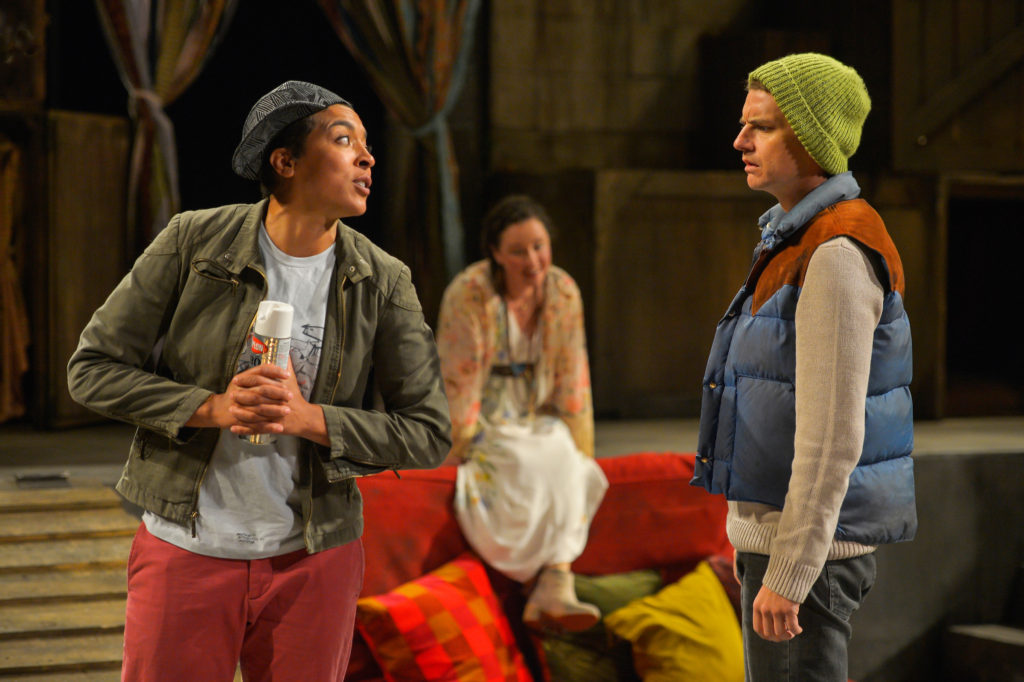
(L to R) Jessika D. Williams (Rosalind), Maryssa Wanlass (Celia), and Patrick Russell (Orlando), photo by Kevin Berne.
Patrick Russell plays her love interest, Orlando, more conventionally, but he has the courage to play his character as being as attracted to Rosalind’s male alter ego as he is to the “absent” Rosalind. Where he especially shines, however, is in a small scene usually played with a light touch where, penniless and hungry, he demands food at knife-point from a group of homeless people enjoying a communal meal. Rather than make fun of the character’s ineptitude at bluffing, Russell plays the scene with believable, fearful recklessness. Even while bringing sympathy to his character’s desperation, he nonetheless seems genuinely dangerous when holding Jacques hostage.
All the World’s a Stage
The high point of the evening follows quickly upon this moment. As a man who genuinely believed only moments earlier that he was going to die at Orlando’s hand, Jomar Tagatac delivers the famous “seven ages of man” speech with an immediacy and specificity that made it integral to the play and indescribably moving. As the melancholic Jacques, Tagatac is extraordinary all night long, which is little surprise to anyone who saw his unforgettable turn in Life Is a Dream at the same theatre two summers ago. His performance, alone, is worth the price of your ticket.
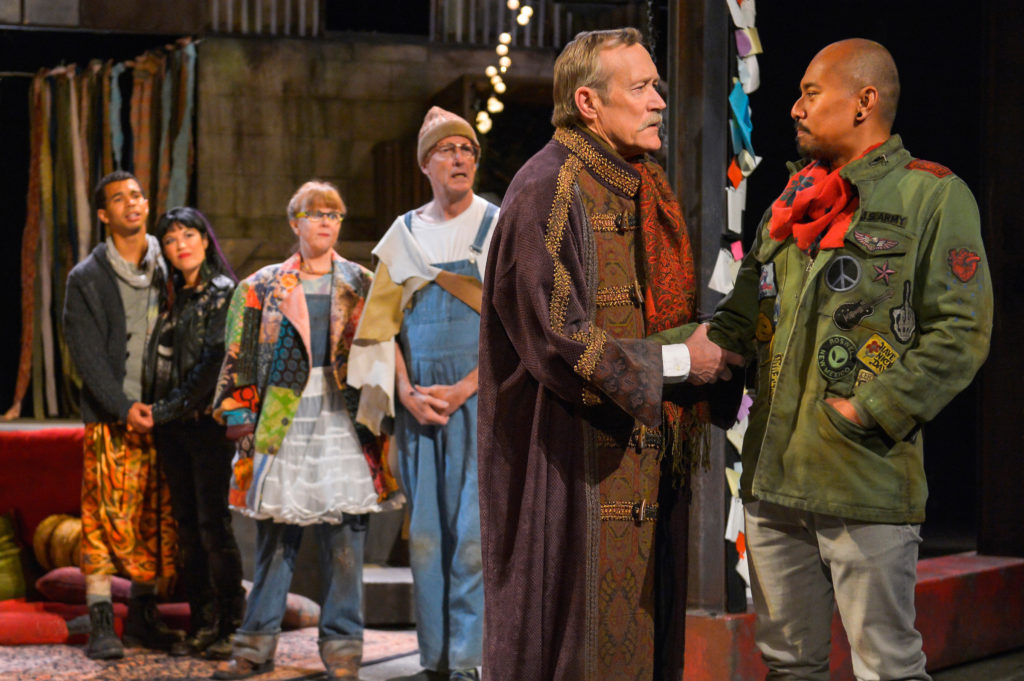
(L to R) William Thomas Hodgson (Silvius), Lisa Hori-Garcia (Phebe), Patty Gallagher (Audrey), Warren David Keith (Touchstone), James Carpenter (Duke Senior) and Jomar Tagatac (Jaques), photo by Kevin Berne.
Company stalwarts James Carpenter as both the usurping and deposed dukes, Patty Gallagher as the unsophisticated country- (or in this case, city-) bumpkin, Audrey, and Warren David Keith as the jester, Touchstone, are uniformly wonderful in their supporting parts. Maryssa Wanlass as Celia, Craig Marker as Oliver, William Hodgson as Silvius and Lisa Hori-Garcia as Pheobe complete the cast, in which there is no weak link.
Ending by Not Ending
The denouement of the play is always a little odd, as the text prominently features a deus ex machina for which we are even more than usually unprepared, but Chiang makes her most deliberate textual changes of the night to this ending by simply eliminating most of it. It is not just her Rosalind who has no desire to change back into a woman. The whole production is most comfortable in the transformative “green world,” and in the end it stays there. After the curtain call, Rosalind’s super hetero-normative epilogue is retained, but so peppered with gender-queer and LGBTQ-friendly asides from the rest of the cast that it ends by meaning exactly the opposite of what it says on paper… thank heaven.
CalShakes is the largest and most sophisticated of the Bay Area’s summer Shakespeare festivals. Its new artistic director, Eric Ting, seems determined to maintain and extend the company’s progressive reputation. In his own directing debut for the company last season, he produced a notable – and notably controversial – Othello, which was pointedly political, via a hyper-Brechtian performance style. As You Like It goes about making its social commentary in a more indirect way, but is every bit as revolutionary. What a great start to the Shakespeare season!
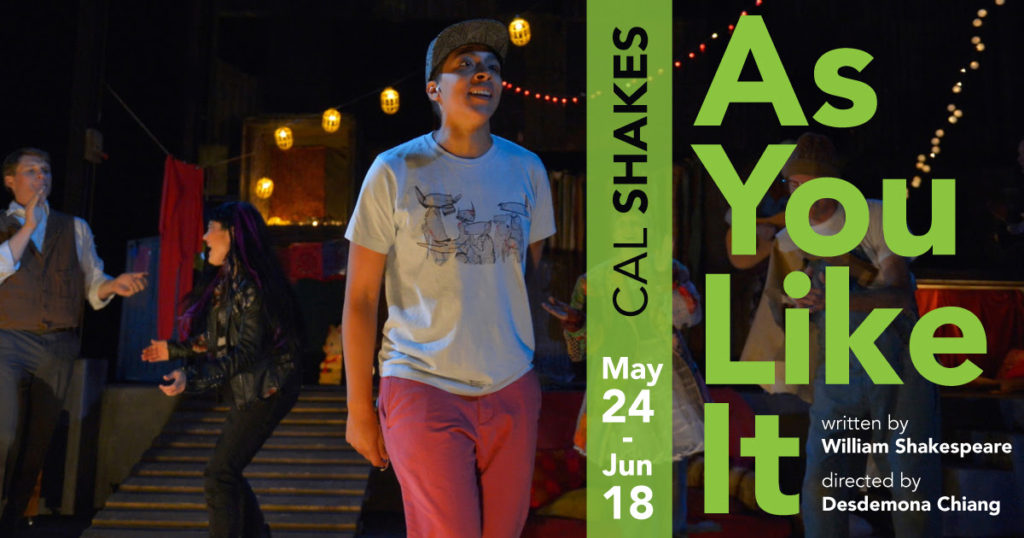
Production Information
AYLI, viewed on May 27, 2017
California Shakespeare Theatre
www.calshakes.org
(510) 548-9666
Tickets $20-96
Bruns Ampitheater, 100 California Shakespeare Theatre Way, Orinda, CA 94563
Tuesdays-Sundays through June 18
Minimalist Tragedy: MACBETH at the Arabian Shakespeare Festival
October 2, 2016 § Leave a Comment
Teddy Spencer is a San Francisco-based actor with a Benedict Cumberbatch-ish look and appeal. He is tall and lanky, possessed of a warm baritone and radiating intelligence. He can be hilariously self-effacing, even goofy, when performing comedy but he is also a formidable tragedian. I first saw him as Orlando in As You Like It at the Marin Shakespeare Company, but it was after seeing him as a steely Iago in Othello with the Arabian Shakespeare Festival that I became a genuine fan. Now he has returned to the latter company as Macbeth in a production that places the focus squarely on him, and he is hypnotic.

Teddy Spencer and Radhika Rao as the Macbeths. Photo by Gregg Le Blanc.
The Arabian Shakespeare Festival is an emerging company under the artistic direction of William J. Brown III. Their mission is to use theatre as a cultural bridge between the Middle East and the West. (Their current production is heavily supported by a sizeable gift from The People of Kuwait.) I was enormously impressed by the previously-mentioned production of Othello, which explored the tensions of assimilating Arabs by taking seriously the Elizabethan connotation of “Moor” to imply someone of middle eastern origin. It was timely and thought provoking.
Their Macbeth is less conceptually related to their mission, as it does not directly imply an Arabian connection despite a passing reference to the Arab Spring in the director’s notes, but that is possibly because any play about an obsessively ambitious strong man coming to power inevitably has more immediate connotations during this frightening election season. The evening’s virtues are quite different from those of the last time I saw this company.
The Real Curse
There is a rich folklore about the cursed nature of the play, but real theatrical insiders will tell you that the main way that it is blighted is that it reads much better than it stages. Despite the high esteem in which the playtext is held, surprisingly few productions of the play come off well. To modern audiences the supernatural element is often silly instead of frightening. Bucket loads of stage blood can, and usually do, become unintentionally hilarious. Relentless misogynistic interpretations of Lady Macbeth often sink the enterprise before it really launches. The reader can find it spooky without “jumping the shark” in their own mind’s eye, but it is downright difficult to make the play work when it has to be materially realized. In performance, it is best to leave a lot to the imagination.
There are some deep textual complexities that cause a lot of issues with producing the show. The only text of the play we have is from the 1623 First Folio of Shakespeare’s work, but scholars have clearly established that that version contains material inserted from a much later play, The Witch by Thomas Middleton, and that Middleton is probably also responsible for heavily cutting and arranging the original text into a streamlined performance text. (Shakespeare could not have inserted the material himself, because Middleton’s play was not written before he died, and therefore probably did not cut it himself either.) The version we have is full of plot holes and contradictions, with an uneven pace. The action flies by in the first half and then grinds to a slog in the second. Lady Macbeth is a powerful presence in the beginning but fades into the background once she becomes queen. Character development in the minor roles is truncated, and sometimes just confusing. It takes some very intensive dramaturgy to keep the play on track.
Keep It Simple, Stupid
Director Terri McMahon avoids many of the most deadly traps by keeping things very simple. A cast of six, performing on a virtually empty set, with minimal props, no fake blood, and evocative contemporary costume bits and pieces performs the show in a drastically cut, fast moving, version of the play. The staging is clean and efficient, with a few moments of clever theatricality. The direction is enhanced by two striking ideas: Nathaniel Andalis, who plays Banquo, continues in a highly original extension of that role to appear onstage after his murder not only as the ghost at the banquet, but also as the visions conjured by the witches, then as the embodied curses and ultimately as a physically manifest malevolent supernatural force intervening against Macbeth. It was both unfussy and theatrically effective. McMahon also chose to place Lady Macbeth’s death (which in only reported in the text) fully onstage and left her body downstage center while the final duel played out. Radhika Rao avoids the clichés in her portrayal of Lady M, and is moving in her later scenes, especially in this interpolated death scene, but the production’s focus is elsewhere.

Nathaniel Andalis as Banquo, Nicole Weber as Fleance, and William J. Brown as Duncan
Actors William J. Brown III, Kirsten Peacock and Nicole Weber do some heavy lifting by rapidly shifting between multiple characters – playing something like half a dozen each. (In a fine show of virtuosity Peacock plays both Macduff and Lady Macduff in the production, both compellingly.) The performance space at the Royce Gallery is tiny, and in combination with the small cast and shortened play, there is little spectacle. Battle scenes and other parts of the play usually populated by crowds are stripped away almost to nothing. Most of what powers a typical production forward is absent from this one altogether.
All that is sacrificed produces one overwhelming and original insight into the play, and makes it riveting. In this minimal staging, we realize that a great deal of the play is surprisingly intimate, and blossoms in this unforced simplicity. Lady Macduff has a touchingly domestic scene with her doomed son. Banquo teases and teaches his son, Fleance, in an almost casual fatherly moment of calm amidst the crisis. The Macbeths agonize over whether to move forward huddled together in a tiny hallway. In stark contrast to the histrionics usually employed, this production favors small, introverted moments.
In this tightly-focused, sometimes suffocating, atmosphere Spencer performs a beautiful miracle. He pulls us into Macbeth’s soliloquies with such unwavering intensity that we actually root for this man. His performance is so contained it feels almost private, but his voice and face are so expressive it is like constantly watching him in cinematic close-up. He seductively whispers his innermost fears, dreams and delusions to us until we feel we have direct access to his damaged (and ultimately damned) soul.
This is not a performance built on charisma and starpower, although Spencer has plenty of both. It is just an actor with enormous courage letting us into his unguarded and unfiltered core. Of the many productions I have seen, this is the first time I have felt that I truly understood the human tragedy of a man who lost himself. In a very Hamlet-ish performance, Spencer fully realizes the protagonist reaching for his destiny, dancing with madness, and ultimately facing death squarely.
It is a small company with a brief run, that deserves your support and attention. Treat yourself and go see this performance.
Production information, per the Festival’s publicity poster:

Seen Sept. 30, 2106.
Still the Most Produced Playwright in America: Shakespeare
September 23, 2016 § Leave a Comment
American Theatre Magazine has released its annual, informative listing of the most produced playwrights in America among the members of the Theatre Communications Group, which consists of virtually all of the USA’s regional theatres. It is a listing I always find fascinating and of great use to my students. Perpetually, however, you have to read to the bottom of the page and look at the small print to find the real answer to the question:
Their footnote on methodology says:
“NOTABLE OMISSIONS: Shakespeare continues his long reign as the most-produced playwright in America, with 91 productions this season (including adaptations). And Stephen Sondheim continues to be the most-produced musical theatre composer in America, with 15 productions this season. It’s not just children who are listening…”

Still #1
The most produced playwright this year that they do count is August Wilson with 17 productions, followed closely by Bay Area playwright Lauren Gunderson with 16. Sondheim would place third on this list (tied with Arthur Miller) if composers were considered.
Still, those four playwrights combined have fewer productions than Shakespeare. You can throw in Ayad Akhtar and Tennessee Williams, the fourth place finishers at 14 each, and you still just tie Shakespeare’s number.
Just sayin’
Till fit time call thee to answer: A Review of OTHELLO at Marin Shakespeare Company
September 4, 2016 § Leave a Comment
That Dameion Brown turns in an impressive performance in his professional debut, and in the challenging role of Othello at Marin Shakespeare Company no less, is almost beside the point. His performance is less important than what he represents as he makes history. Brown, you see, is only a year out of prison after 23 years behind bars. His training is a result of Marin Shakes’ Arts-in-Corrections program under the direction of Managing Director Leslie Currier. His only previous experience was as Macduff in Macbeth in a production at Solano State Prison.

Dameion Brown as Othello. All photos by Steve Underwood.
“Rough” Theatre
If you knew none of that, and watched Robert Currier’s production without any context, the surface appearance was that of a fairly ordinary production of Shakespeare’s tragedy. Marin’s approach to conceptualizing and design has usually been conventional, and always a little “rough” in Peter Brook’s appreciative sense. This production is no exception. It is set in period, with fairly low-budget set and costumes; interpretively uncontroversial.
Knowing Brown’s story, however, one cannot help but view this production through the filter of one’s knowledge of our dysfunctional criminal justice system, its disproportionate effect on men-of-color, and the growing frustration (at least in liberal enclaves like the Bay Area) that unjust scapegoating has become so systemic that it may be a bigger problem than the problems corrections supposedly correct.
By making the brave decision to cast Brown, and to highlight his incarceration record rather than downplay it, the production instantly brings us into dialogue with Shakespeare in an almost visceral way. Nothing special needs to be adjusted to make clear the “othering” of Othello, the casual dismissal of everything good about him, while social prejudice insidiously makes all plots against him easily accomplished. Brown’s presence is statement enough.
It also reminds us of why drama can be so central to social discourse. Brown is, after all, an example of rehabilitation. Example shows us some paths forward that are not about locking young men-of-color up and throwing away the key. “Law and order,” so much a topic of this year’s election season, suddenly seems to be a less automatic pairing.

Dameion Brown as Othello, Cassidy Brown as Iago
Inkblots
I liked this production, without finding it revelatory about the text. (For contrast, here is a review of a production of Othello by the Arabian Shakespeare Company from 2014 of a production that I did find illuminating. By the way, ASC company has a forthcoming Macbeth that I am itching to see already.) What I think Marin does especially well, however, is have a sense of the current moment that – like a Rorschach inkblot – pulls the submerged ideas out where they can be examined. Last summer their Richard III was positively Trumpian without resorting to any obvious imitation or parody. This Othello is just as current and unnervingly relevant. That is the result of deepest values of the company, like the long-term commitment to Arts-in-Correction and the successfully empowering Brown to see his own possibility, not to pasted-on references that make it temporarily topical. They do not so much uncover new aspects of Shakespeare’s plays as simply lay them bare, in the right context and at the right time.
That is not to say that there was not was much to admire in numerous performances, in addition to Brown’s. Company stalwart Cassidy Brown, cast almost ridiculously against his usual comic type, is a fine Iago and a heroically supportive stage partner. Luisa Frasconi, despite being dressed in Renaissance costume, brings an attitudinally contemporary edge to Desdemona that fits well with the play’s context. Elena Wright, usually a leading lady, is powerful as Emilia. Currier’s staging was clean, efficient, and communicative.

Luisa Frasconi as Desdemona with Dameion Brown.
When all is said and done, however, I think that most of the audience seemed less focused on what they were seeing onstage than what they were seeing in themselves. Isn’t that what theatre is supposed to help us do?
Othello
Marin Shakespeare Company
Forest Meadows Amphitheatre at Dominican University of California
890 Belle Avenue, San Rafael, CA 94901
Aug. 26 to Sept. 25, 2016
(seen Sept. 2, 2016)
$10 to $35
Admission at the door is $35 general; $32 senior; and $10 youth (25 and under). Preview performances are $12 per person. “Pay Your Age” is offered to audience members between the ages of 26 and 34 when purchasing tickets at the Box Office on the day of any performance, with valid identification. Marin Shakespeare Company also offers those 65 and over half-price tickets at Senior Matinees and those ages 18 and under admitted free at Family Matinee performances.
http://marinshakespeare.org/tickets/ or 415-499-4488
A Woman in the Lead: A Review of HAMLET at Santa Cruz Shakespeare
August 26, 2016 § Leave a Comment
At Santa Cruz Shakespeare Kate Eastwood Norris is not only a woman playing Hamlet, she is playing Hamlet as a woman – and the result is every bit as wonderful (in an especially Santa Cruz-ish way) as you might expect.
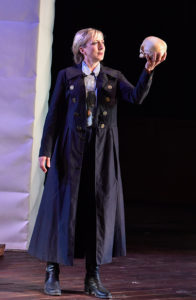
Kate Eastwood Norris (Hamlet) in Santa Cruz Shakespeare’s 2016 production of Hamlet 2016. Photo by Jana Marcus.
Although a woman playing the role of Hamlet is not nearly as rare in theatre history as most would suppose, or even unique to the San Francisco Bay Area this season (given Shotgun Players’ conceptually fascinating Hamlet roulette which randomly selects a women for the role in about half of its performances) Ms. Norris in the title role at Santa Cruz Shakespeare is notable for a number of reasons. First, she is genuinely good in the part. Second, she debuted in the part the same night that Hillary Clinton became the first woman nominee of a major party for President of the United States and the historic resonance with the audience was palpable. Most of all, however, what makes this casting particularly interesting is that it is situated within a production that genderbends a number of roles in ways that illuminate the play anew.
Gender Equity In Action
This is the second season in which Artistic Director Mike Ryan has pursued a policy of gender equity in casting. This is no mean feat, since Shakespeare’s plays do not feature anything like equal balance of male and female characters. Most companies that are trying to address this concern (not nearly enough) do so by pursuing what is known as “gender-blind” casting, wherein women are cast in male gendered parts but the convention is that the underlying gender of the actor is irrelevant and essentially ignored. Others do so by “conceptual casting,” in which women simultaneously “play” and “comment on” their characters. In this case, the female interpretation of the male role becomes the major interest. This tends to be especially true of all-female productions.
Ryan has consistently taken a different tack. At SCS, the roles have been regendered to match that of the actors playing them. In this production, not just Hamlet, but also Polonius, Rosencrantz, Guildenstern and Francisco all become female characters. (Unsurprisingly, from the point of parity, no gender bending moved characters from female to male, but – at least in the case of Ophelia – this still had interesting consequences.) Although it is the sort of change that makes purists blanch because it alters the play in some fundamental ways, it also provides new perspectives on often overly familiar literature that can (when well done) make it a totally new experience. This has become the house style at SCS concerning gender, although the company (or at least its predecessor company, Shakespeare Santa Cruz) has long practiced color-blind casting, as it does in this production.
Director Paul Mullins* handled this reframing of the play with exceptional skill and succeeds in helping us rethink this masterpiece. (His staging is beautiful, and his pacing and shaping of the performance masterful but it is his interpretive skills that set him apart here.)
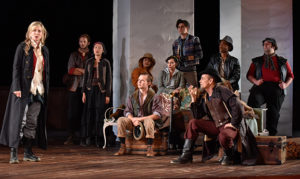
Kate Eastwood Norris (Hamlet) and Larry Paulson (Player King) and the other Players in Paul Mullins’ beautiful staging. Photo by Jana Marcus.
Visuals
Collette Pollard’s set for this outdoor venue is a large neutral space punctuated with seven tall white columns. (Kent Dorsey’s lights made little impression in the bright afternoon sun at the matinee I attended, but might be a totally different experience during evening performances.) B. Modern’s eclectic costumes feature everything from plaid-skirted schoolgirls to medieval robes, but largely settle into a vaguely Edwardian look. It is a kind of alternate Edwardian universe, however, where same-sex marriage is so routine that the possibility raises no eyebrows. Proudly liberal Santa Cruz has, apparently, always been Santa Cruz. (Except for pronouns, no lines were changed in this version to reflect the gender-bending. Even Hamlet’s extremely hetero-normative “Will thou be a breeder of sinners?” survived the editor’s red pen, although it no longer seems a logical concern.)
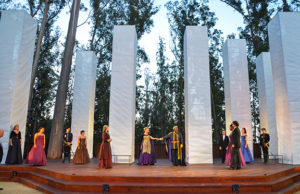
Set by Collette Pollard. Costumes by B. Modern
Which Hamlet?
For ardent Shakespeareans, the “insider baseball” for any production of Hamlet is which Hamlet we see. The text exists in three vastly different Renaissance versions. Two of them get most of the attention. The so called “Second Quarto” of 1604, and the First Folio of 1623 differ in length by some 150 full lines. Q2 contains an entire soliloquy that is cut from the Folio, and there are hundreds of minor wording changes. This production cut a good deal of the text, with some interesting minor rearrangements here and there, but generally followed the Folio version.
It is the third alternative that can provide, continuing our baseball metaphor, the real curveball. The “First Quarto” of 1603 is a bizarre text, half the length of the others and featuring what almost sounds like a paraphrase of the text to which we are accustomed. Most scholars believe that it is a version of the text put together from memory by actors, observers (or both) without consulting a written manuscript.
However odd it is, and Q1 is really odd, it has a few interesting features which might relate to it being pieced together after watching an actual performance. Most significantly, the scenes are in a different order. The most famous soliloquy in the canon, “To be or not to be,” sits at the start of Act II instead of the beginning of Act III.
Santa Cruz performs the piece in Q1 order, although it utilizes the wording from the F1 text. This makes a world of difference. Hamlet becomes far less indecisive and confused. In the typical order, Hamlet confirms his uncle’s treachery through a performance of a play-within-the-play that replicates the conditions of his murder of Hamlet’s father. He seems overjoyed at this, but in the very next scene he returns with his famous contemplation of suicide. Modern actors go through all kinds of psychological twists to make sense of this bizarre emotional reversal.
In Q1 order, however, (as performed at Santa Cruz) Hamlet is suicidal when she is not sure whether her father is a truthful ghost or a deceiving demon, but snaps back out of this depression once the playlet reveals the truth and never wavers thereafter. This is not only sensible, but thrilling. Eastwood Norris’ Hamlet is far stronger than that of most men I have seen play the role, flirting with madness to a far smaller degree, which is largely because of her own laser-like focus, but the less confusing order of events also propels her forward in a manner that is more palpably immediate and less intellectually abstract.
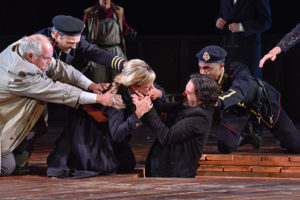
Mike Ryan (Horatio), Kyle Hester (Marcellus), Kate Eastwood Norris (Hamlet), Cody Nickell (Laertes), and Christian Strange (Barnardo) in Santa Cruz Shakespeare’s 2016 production of Hamlet 2016. Photo by Jana Marcus.
Performances of Note
The production features a number of very notable performances. Bernard K. Addison plays both the ghostly King Hamlet and the villainous King Claudius. Cody Nickell has the unenviable task of finding a way to keep the complexity in Laertes’ character, although an awful lot of social conditioning teaches us that someone who would plot the death of a woman (as Hamlet is in this case) is not just duplicitous but also a bully. Even viewed through that lens, however, he finds the redeeming humanity in the character. Mike Ryan is a solid and precise Horatio.
Patty Gallagher (a performer whose work I consistently admire) brings a pathetic depth to Polonius that I have rarely seen. She seems less a silly old fool than a woman who is hopelessly double-bound by the responsibilities she is given and the disempowering standards of behavior to which she is held (restricted?) while trying to achieve them. Although Eastwood Norris’ Hamlet provided a very interesting resonance in the shadow of Hillary Clinton’s achievement, Gallagher’s Polonius was equally reminiscent in another way as we saw and judged her quite differently than we would a man in the same situation.
Mary Cavett as Rosencrantz and Katherine Ko as Guildenstern are guileless schoolgirls, clearly out of their depth. In this one case, I worried about the difference casting women in the roles made. It was not their performances, which were impeccable, but the context. When I learned (spoiler alert) that Hamlet had substituted an order than ended with their execution, Hamlet’s declaration that “they come not near my conscious” proved the least sympathetic moment of the evening – a touch of calculated cruelty that made me cringe, and made me think about why it felt so different from how this moment usually plays.
See This Production? Absolutely!
Ryan’s leadership of SCS is brave, and in this case, Director Mullins delivered on his mandate and made a female Hamlet feel both inevitable and historic at once.
*Although we have not seen each other since, full disclosure is that Mullins was a classmate of mine in the Professional Theatre Training Program at Southern Methodist University in the early ’80s.
He were an excellent man: a review of MUCH ADO at CalShakes
May 30, 2016 § Leave a Comment
As has been their pattern for the last few years, the California Shakespeare Theater (CalShakes) has opened its season with a quirky, challenging take or adaptation of a Shakespeare play. (Last year it was an almost all-female Twelfth Night.) This year it is an adaptation of Much Ado About Nothing, which greatly streamlines the play, presented by a multi-ethnic and frequently gender-switched ensemble of eight.
Directed by off-Broadway fixture Jackson Gay, who also adapted the play with Kenneth Lin, the production is successful at condensing the sprawling plot into a tightly focused hour-and-a-half. It is especially entertaining when the gender-switched central couple, Beatrice (played by James Carpenter) and Benedick (played by Stacy Ross) hold the stage.
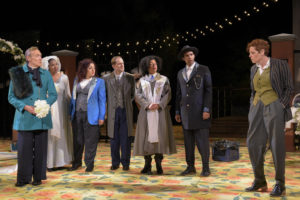
(l to r) James Carpenter as Beatrice, Safiya Fredericks as Hero, Denmo Ibrahim as Claudio, Anthony Fusco as Leonato, Rami Margron as the Friar, Lance Gardner as Don Pedro, and Stacy Ross as Benedick in California Shakespeare Theater’s production of MUCH ADO ABOUT NOTHING, directed by Jackson Gay; photo by Alessandra Mello.
Storming the Gates?
Conceptually, it is far murkier. Set, according to the advanced publicity, behind the scenes of “the biggest celebrity wedding in America,” where the catering staff acts out their pieced-together understanding of the story underneath the scandal-plagued ceremony they have just served, the adaptation succeeds best when speeding quickly past the issues of race and class it promised, in that same preview, to raise. Much Ado does not prove a very good vehicle for discussing income inequality or class privilege, largely because the original plot focuses so clearly on critiquing male privilege. Additional text by Kenneth Lin, mostly a smattering of amusingly snarky couplets, alludes to the notorious indifference of the one-percenters, but does little to further the social critique. (No rants from me against updating Shakespeare, or conceptual productions. I usually favor them. Just noting that, except in the arena of gender politics already present in the play, this particular concept did not have much to say.)
The location dictated by this concept (the untidy staging space behind a wedding venue) limited scene designer Erik Flatmo’s options. His realistic, but therefore messy, set worked well as a floorplan without giving us much to look at. The most prominent feature on the set, a second-story balcony where we are told the play’s thug, Borachio, created the illusion of seducing the confusingly named heroine, Hero, was not used for that, or really any, purpose. Of course that event is only related through exposition in the play, although it is often interpolated as a mime, but then if you are not going to stage it – echoing the issue with the overall concept – why is this feature there at all?
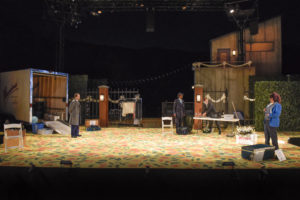
Erik Flatmo’s set for the California Shakespeare Theater’s production of MUCH ADO ABOUT NOTHING, directed by Jackson Gay; photo by Alessandra Mello.
Costume designer Karina Chavarin provides very effective pieces to be layered over the basic catering uniforms to indicate the fictional characters of the play. Visually, the heavy lifting is done by lighting designer Paul Whitaker, who not only shapes the stage with interesting compositions but helps us alternate between the framing device and the play itself with great dexterity.
Genderbending
What does work, and might have worked equally well without any added concept, is the virtuosity of the acting. The brilliant Anthony Fusco is underutilized in this production but alternates rigidly patriarchal Leonato with an “indignorant” Dogberry with speed and skill. Rami Margron, a company stalwart, is likewise used in the smallish parts of Margaret and Borachio, but single-handedly makes clear the power of cross-gender casting in the crucial but thankless role of the friar. Spoiler alert: after Hero is brutally rejected by her fiancé, her feudal lord and ultimately her father, it is the unassuming friar who steps forward to declare belief in Hero’s innocence of the charges of infidelity waged against her, and to provide the plan that ultimately resolves everything happily. In his one speaking scene, the friar explains that he knows Hero is telling the truth just by genuinely observing her reactions. Although in this production the character is still gendered male, watching a woman play the part provides a perspective on empathy that I have never experienced after seeing the role traditionally cast.
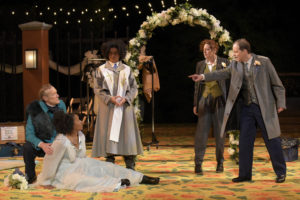
(l to r) James Carpenter as Beatrice, Safiya Fredericks as Hero, Rami Margron as the Friar, Stacy Ross as Benedick, and Anthony Fusco as Leonato in California Shakespeare Theater’s production of MUCH ADO ABOUT NOTHING, directed by Jackson Gay; photo by Alessandra Mello.
Stacy Ross gives us an original reading of Benedick through deftly handling the cross-gendering of her character so that she seems perpetually present as both the character and the underlying (female) cater-waiter presenting the story. Her intelligent interpretation of the part is informed by her gender, and we see her perspective in the way in which even she is surprised by the choices Benedick makes and the struggle to embody them.
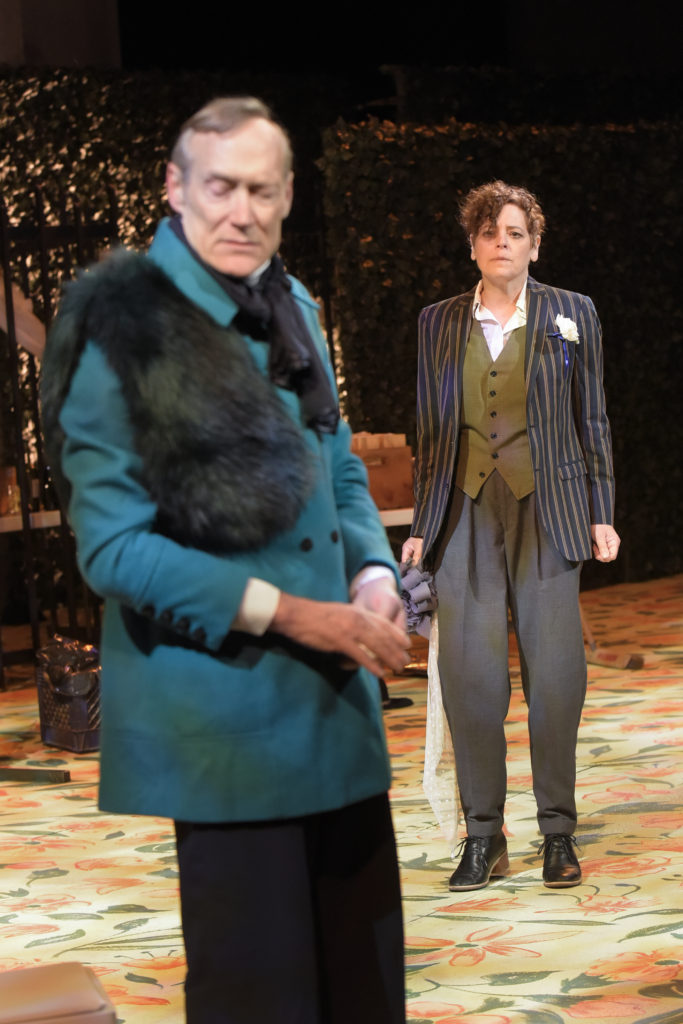
James Carpenter as Beatrice and Stacy Ross as Benedick in California Shakespeare Theater’s production of MUCH ADO ABOUT NOTHING, directed by Jackson Gay; photo by Alessandra Mello
The revelation of the night is James Carpenter in the role of Beatrice. He was seen a year ago cast perfectly to type in Pygmalion as Doolittle. It is hard to imagine someone less likely to play Beatrice, but he does it with such humanity and emotional grace that the part seems newly minted. Her pain and frustration reads as all the greater because it is clear (when situated on a male body) that they are entirely artificial limitations placed on her.
The versatile cast is rounded out by Patrick Alparone, Safiya Fredericks, Lance Gardner, and Denmo Ibrahim.
CalShakes is the big dog among Bay Area Shakespeare festivals. It has consistently high production values and standards. It is situated in the very diverse East Bay and has a great track record of developing and serving a contemporary audience. Much Ado does not quite deliver on its potential to comment on social disparity just down the freeway, but it is still a worthwhile night in the theatre–especially recommended for those who know the play well and are ready to see the traditional comedic war-of-the-sexes battle lines redrawn.
PS: CalShakes has a new artistic director, Eric Ting, who welcomed the audience warmly for this opening night but it will be later in the season, when he makes his directorial debut with Othello, before we get a full sense of what he will bring to the company.
Details:
California Shakespeare Theater’s production of Much Ado About Nothing by William Shakespeare, adapted by Kenneth Lin and Jackson Gay, with additional text by Kenneth Lin.
Directed by Jackson Gay. Designed by Eric Flatmo (set designer), Karina Chavarin (costume designer), Paul Whitaker (lighting designer), and Olive Mitra (sound designer/composer).
May 25–June 19, 2016
(Tuesdays through Thursdays at 7:30pm, Fridays and Saturdays at 8pm, Saturday Matinee June 18 at 2pm
Sunday Matinees at 4pm)
Bruns Amphitheater, 100 California Shakespeare Theater Way, Orinda, CA 94563
Long Live the Revolution: a review of HAMLET at Shotgun Players
April 30, 2016 § Leave a Comment
A generation ago, there were two surefire claims to bragging rights among serious Shakespeare playgoers: that you had personally seen one or both of the two most revolutionary productions of the 20th Century–Peter Brook’s Midsummer and Steven Berkoff’s Hamlet.
Brook’s white box set became famous, and going even further towards stripping a play down to its essence, Berkoff reduced Hamlet’s spectacle to a single taped white line across the floor, inspiring an entire generation to a more visceral and less pictorial approach. For those who (like me) missed those heady days, the spiritual successor to Steven Berkoff’s famously minimalist production has come to Berkeley’s Shotgun Players.
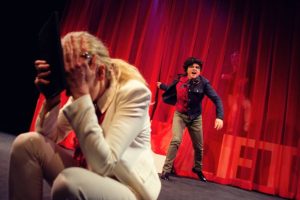
El Beh as Hamlet and Beth Wilmurt as Gertrude. (I think that is David Sinaiko playing the dying Polonius just visible through the curtain. ) This is not the same casting configuration I saw, as explaned below…
Shotgun Shakespeare
Shotgun is celebrating its 25th anniversary season, and it is hard to imagine any production that could better convey their aesthetic, showcase their artists and speak to their particular audience than their current offering. Directed by long-time company member Mark Jackson*, the production features a four-woman/three-man, vaguely androgynous, multi-ethnic ensemble presenting a considerably shortened–and therefore very fast moving–version of the work. Nina Ball’s set is a bi-level black platform with a layer of intense red curtains behind each level, and six chairs that mostly live along the side walls of the theatre but occasionally make their way onstage as a throne, a bed or a grave.
Jackson’s staging is clean, and in his signature style, very physical. Isolated iconic gestures associated with each character are the dominant motif. Christine Crook’s costumes are simple, suggestive bits and pieces – jeans, sweaters, jackets, coveralls, and a long, flowing blouse for Ophelia. Heather Basarab’s lights (and deep shadows) are intense and often directionally moody. Matt Stines’ blatantly theatrical sound design is purposely foregrounded, most prominently in the long fencing scene at the end of the play–noisily fought with invisible rapiers. Perhaps the most noticeable visual element of the production is that all the actors carry (but never consult) scripts with them, which they use as props whenever possible.
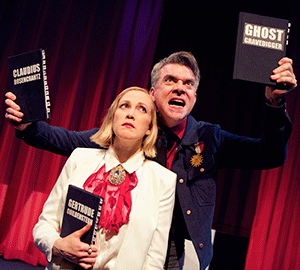
Kevin Clarke and Megan Trout, as Hamlet upbraiding his mother with the images of his father and uncle. (This is also not the cast configuration I saw.)
Audience Partnership
As one might expect of Shotgun, the work is raw, rough, and unsentimental. Berkeley’s sophisticated audience is called upon both intellectually and imaginatively to extend the performance far beyond what is materially presented in front of them. The cutting is severe. The opening scenes on the battlements, the traveling players, Fortinbras, and most of Act IV all disappear.
As is often the case with minimalist productions, so much is gone that the production is probably incomprehensible to anyone who does not already know the plot–but it is a safe bet that virtually no one in Shotgun’s audience has trouble filling in the rather massive holes in the remaining narrative. As but one example, Hamlet’s soliloquy that begins “Oh, what a rogue and peasant slave…” is (mostly) retained, but since it does not follow on the appearance of the troupe of traveling players, Hamlet’s musing on surface appearances versus deep feelings now references the real actors in Shotgun’s production instead of the pretend ones visiting Elsinore. That is a logical leap a couple of levels of metaphor removed from the play as traditionally presented, and probably can’t be made unless you know the original context–but it tells you a lot about Shotgun that it presented no problem to anyone on the night I saw the show. (The actual performance of the players’ The Mousetrap, for those who are worried, is reassigned to Hamlet and Ophelia.)
Given the severity of the cutting, reassignment of lines, and occasional rearrangements of the order of speeches, I would have preferred a little more dramaturgical expertise behind the cast’s collective cutting. I might personally have encouraged consideration of the otherwise dubious First Quarto’s placement of “To be or not to be,” which makes far more sense when located much earlier in the show, as Q1 has it, especially when it is laid as bare as it is in this much-shortened version. It is part of the dedication to the ensemble, however, that dictates an equal voice for the actors in matters like this–matters which are usually deferred to “experts” and decided long before the actors are even cast.
Shakespeare Roulette
The production would be interesting enough if it was conventionally cast and presented, but it has an extra level of artistic risk and emotional excitement because it performed in what the company calls “roulette style.” All seven cast members (and an understudy) have memorized the entire play, and just before the performance a random drawing determines which actor will play which part(s) that night. As it happens, I saw the closest fit to a traditional Hamlet (actor Nick Medina) play the title role on the night I attended, and perhaps that made it more easily digestible, but I also saw company member Kevin Clarke play Ophelia – a sensitive and beautiful performance despite the fact that he made almost no attempt to impersonate a young woman. The dynamics of the tragedy emerge from the circumstances, not from the actors’ appearances and personalities. Of course, no two performances are even remotely the same.
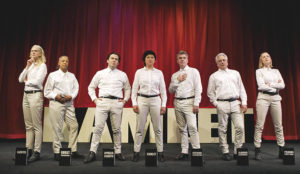
Beth Wilmurt, Cathleen Riddley, Nick Medina, El Beh, Kevin Clarke, David Sinaiko, and Megan Trout prepare to pick their roles for the night in “Hamlet” at Shotgun Players. (Photo by Pak Han)
Not every artist would be willing to place him/herself under this pressure, but it is typical of Shotgun’s players that they are attracted to the unorthodox and the risky. On the night I saw the show, El Beh (last seen at Shotgun as Emily in Our Town) played Laertes, and Cathleen Riddley played Claudius (and Rosencrantz). That two women of color were randomly placed in the roles of the two violent male antagonists was, to say the least, illuminating. The youngest person in the cast, Megan Trout, drew the oldest characters: the Ghost/Gravedigger. The evening was filled out with Beth Wilmurt as Gertrude/Guildenstern and David Sinaiko as Polonius/Osric.
The particular performance that I saw was not word perfect, but the minor wobbles and unapologetic prompting did not dull the sense of danger emerging from a previously staged, but still almost improvisatory, first “run-through” in this configuration. Like the rehearsal period that actors so cherish, discoveries were being made right on the spot, and that forced both actors and audience members to pay close attention.
Designed for Multiple Viewings
This is not what one of my colleagues calls “gift shop Shakespeare.” It is not pretty, celebrity studded, or made topical. Jackson and his cast are excavating the essential text from under a lot of accumulated baggage, and what emerges is often highly original and gut wrenching. (I was particularly struck by the stunning manner in which Gertrude’s strangely incongruous description of Ophelia’s death was recontextualized in a way that finally made sense.) That it can also be, from moment-to-moment, a bit hit-or-miss is beside the point. After all, you can always come back to another performance–a possibility made easy because Shotgun sells tickets in three performance packages–to see it all handled differently another night. From what I could ascertain at my particular performance, a lot of patrons were seeing the production for a second time. It is a trend that I predict will continue with this fascinating production as it continues its run, as part of a season-long repertory, through January 2017.

*As a matter of full disclosure, (although we have never worked together directly) both Mark Jackson and Matt Stines have been my colleagues at San Francisco State University, and Megan Trout is one of the program’s graduates.
Great New Resource: Clear Shakespeare
February 24, 2016 § Leave a Comment
I like to think of myself as a cool, objective reviewer (especially of electronic resources) but occasionally I can’t help myself and just go all-in fanboy. Such is the case with my new obsession, an inspirational and exceptional resource, Clear Shakespeare: The Read-Along Shakespeare Podcast.

clearshakespeare.com
Created by Akiva Fox, a former Literary Manager for D.C.’s famed Shakespeare Theatre Company, this is the most genuinely demystifying tool for reading and understanding Shakespeare’s plays of which I know. This is, in part, because he in unafraid to use the multi-episode format that podcasts do so well for discussing the plays line-by-line in exceptional detail. As a result, his explication of A Midsummer Night’s Dream is spread across six podcasts totaling nine hours of audio. (Hamlet is even longer, with nine individual podcasts!)
So why is this so useful? Fox has one simple insight that powers everything. Most students (and even experts) don’t really understand the language. Most editions don’t help much. They try, of course, but glosses of all the difficult words do not fix the problem, because even when you know roughly what each word means the issue is more often grasping the entire phrase or putting those words in context.
Fox takes you through the plays, discussing one unit of meaning – usually a sentence but sometimes longer connected thoughts – at-a-time. He avoids too much interpretation, in favor of just explaining what is being said while you follow along with your favorite printed edition.
If listening to an expert talk about the language of a play for nine hours sounds more like a circle of hell than fun to you, as I admit it generally does to me, then all I can say is you haven’t heard Akiva Fox do it. He is witty, entertaining, and enormously empowering. He really believes that listeners can hear and understand this language with just a little help, and studiously avoids telling you what you are supposed to think and feel about it all. This ain’t “schoolmarm Shakespeare”! His site name is well chosen, because he really does make things clear.
Best of all, these podcasts are available for free. (Pitch in a few bucks if you can, but for starving artists and struggling students this guy is a godsend!) Want to see, or rather hear, why I am so gaga for him? You can listen to a sample here.
So far only Hamlet and Midsummer are available, with Julius Caesar coming next, but the plan sounds extensive.
My advice? Download old episodes as soon as possible, and subscribe so you don’t miss anything in the future.
Shakespeare Resources
January 9, 2016 § 1 Comment
The New York Public Library announced this week that they were making 180,000 digitized public domain images available for hassle-free downloading and use. (See the announcement here.)
The collection contains some wonderful images of interest to Shakespeareans. As an example, have a look at this “book” of images related to Macbeth. It contains numerous photos of full productions like one of the Old Vic and the famous Orson Welles “Voodoo” Macbeth, and a set of photos of studio shots of Lady Macbeths like Sarah Bernhardt, Sada Thompson, Ellen Terry, Lili Langtry.
The collection is especially rich in photos from the early years of the New York Shakespeare Festival’s free Shakespeare-in-the-Park productions – like this one of Christopher Walken in Macbeth:
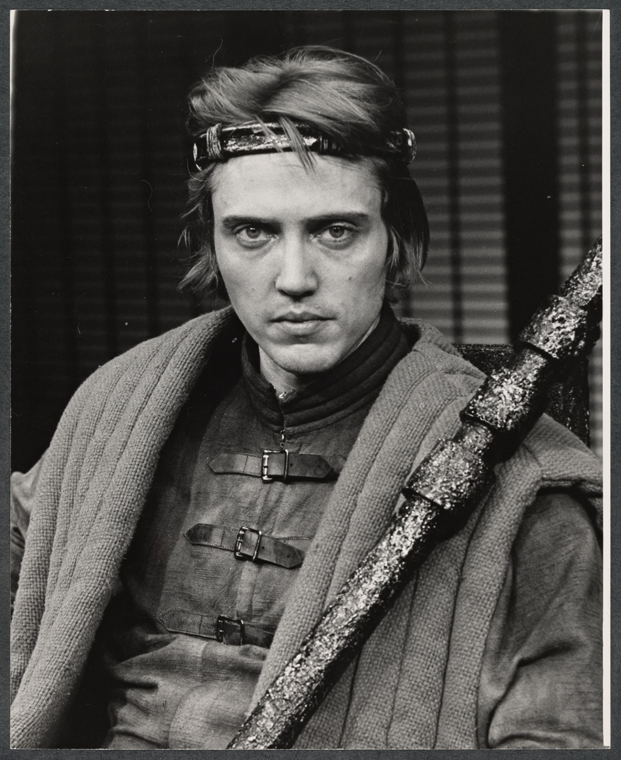
Walken in Macbeth, 1974
The possibilities are extensive. Next time you can afford to get sucked into an hour or two of browsing, check it out.